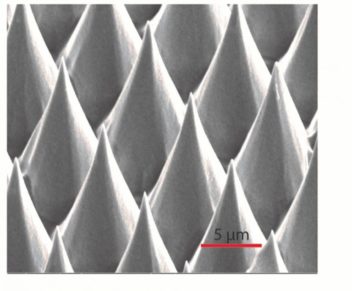Nature’s way of keeping surfaces clean
Nature has long been an inspiration for materials engineers and designers — just think of Velcro, the ubiquitous stick-to-itself tape that was created by a Swiss engineer after he picked burs out of his dog’s coat. Now a team of NTNU researchers has looked in more detail at how tiny conical structures on a lotus leaf or insect’s wing repel water and help keep it clean.
“Nature has engineered surfaces like leaves or skins that are capable of interacting with water droplets in different ways,” says Wenwu Ding, a PhD candidate in the Department of Energy and Process Engineering. “For example, if you deposited a droplet of water on a lotus leaf, the droplet will roll on the surface and collect dust particles, keeping the leaves clean even when the lotus is growing in dirty water. We call this property self-cleaning or a super-repellent state.”

Wenwu Ding photographed this conical structure at a micro level at the NTNU NanoLab. The structures look a little like spikes. Photo: Wenwu Ding.
Cicada wings have a similar conical structure, which allows the insect to keep its wings clean and dry. When researchers and companies have made artificially fabricated micro-sized conical structures, they’ve also found that these structures repel water and dirt.
Ding says that researchers are interested in this particular property because it could be used to develop ice-repellent and self-cleaning surfaces. So he and his NTNU colleagues Professors Maria Fernando and Carlos Dorao decided to look more deeply into details of the actual structure to see why it works so well.
“Our results show that conical structures achieve their super repellent state as a geometrical property of the cones. In particular, as the cones get sharper the property is enhanced,” he said.
The researchers also found that reducing the steepness of the angle between the cones helps make the surface stronger.
The results of their work have been published in Applied Physics Letters.
Reference: W. Ding, M. Fernandino and C.A. Dorao. Conical micro-structures as a route for achieving super-repellency in surfaces with intrinsic hydrophobic properties. Appl. Phys. Lett. 115, 053703 (2019); https://doi.org/10.1063/1.5096776





